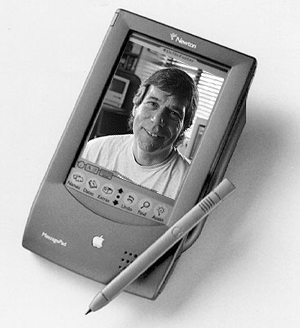April 23rd, 2010
“Back in 1998, Apple killed the floppy drive with one fell swoop. Killing the PC desktop won’t be as quick and easy, but Apple will do it over time. It started with the iPhone, and in a few years we won’t even remember the Finder.”
– Sachin’s Posterous, in a very thought-provoking post. I often wonder what OS X+1 will look like. Not OS X 10.7 or 10.8, but after the tens are done. What does the next-generation, non-OS X-based operating system look like?
[Via Sir Kendal.]
Posted by davelawrence8 at 6:22 am on April 23rd, 2010. Categories: ipad, OS X. Tags: finder, ipad, iphone, mac, operating system, OS. Subscribe via RSS.
May 18th, 2009

The RetroMacCast team recently aired an interview with Steve Capps, an Apple Fellow, original Macintosh team member, and Newton developer, in episodes 115 and 116.
Capps is one of the genuine Good Guys: decent, hard-working, and has a great way of talking about his work on the original Mac and Newton. He helped work on the Lisa, the Mac’s Finder, the Newton OS 1.0 and 2.0.
He eventually left Apple to work on Windows Active Desktop idea and Microsoft’s Internet efforts. Since then, he’s worked on AliceX – an iPhone version of the only Apple-released game ever available on the Macintosh.
There’s a Fake Steve Capps blog (his real blog, actually), a Steve Capps Day, and a real sense of respect surrounding the guy.
Check out the podcast (iTunes link) for a great look back at the glory days of the Mac and Newton systems, and a super interview with one of the great individuals in Apple history.
Posted by davelawrence8 at 6:11 am on May 18th, 2009. Categories: newton history. Tags: alice, alicex, finder, iphone, mac, macintosh, newton, steve capps. Subscribe via RSS.
October 30th, 2008

Saw this rumor (a few times, actually) over at Webmonkey: a Cocoa OS X Finder may be on its way, starting with Snow Leopard.
But wait. Isn’t the Finder an all-OS X beast?
That got me wondering what, exactly, is the difference between the Cocoa and Carbon development environments. I’m not programmer, so I needed a low-brow explanation.
Just before Apple launched OS X, Macworld had this article describing the basic differences between the two. I like to reference the original Mac OS X introduction video, by Mr. steve Jobs, as a primer, too. He goes into detail about the different levels (kernel, Carbon/Cocoa, OpenGL, etc.), which helps.
My basic understanding: Carbon is for applications that need to reference the old, OS 9 way of doing things while operating in OS X. Cocoa is an all-OS X environment, and lets developers use stuff like Core Audio and Core Animation.
Even at Apple, the two platforms have their place. Mail is a Cocoa app. iTunes is a Carbon app – a hold-over from OS 9. PhotoShop, as it stands now, is a Carbon application. Again, in terms of development, it’s an OS 8/9 relic. But that may be changing. Adobe has already produced a Cocoa-based app in Lightroom, so hope springs eternal.
Now, 32 bit versus 64 bit? That’s a whole ‘nother ball of wax.
Posted by davelawrence8 at 7:37 am on October 30th, 2008. Categories: software. Tags: adobe, apple, carbon, cocoa, finder, mac, macintosh, OS X, photoshop, snow leopard, software. Subscribe via RSS.

